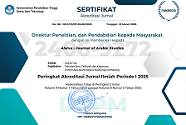Hubungan Kata dan Makna dalam Bahasa Indonesia dan Bahasa Arab: Kajian Semantik
DOI:
https://doi.org/10.21580/alsina.5.1.16868Keywords:
Arabic, Indonesian, meanings, semantic, wordsAbstract
This study aims to determine the relationship between meaning and words in Arabic and Indonesian and their correlation. This research falls under the category of a literature review. Various books, dictionaries, and scholarly journals were used as data sources. Data was obtained through documentation and analyzed using the Miles and Huberman approach. The study results indicate that this linguistic phenomenon provides deep insights into the interaction between meaning and word forms within different cultural contexts. The findings reveal that the linguistic structure and dynamics of Arabic and Indonesian are influenced by phonotactic and semantic factors and the pressure to communicate efficiently. Furthermore, analyzing loanwords and meaning changes across languages enhances understanding of linguistic adaptation processes and semantic shiftsDownloads
References
‘Izza, Amira Nayla. “Perbandingan Kata Bahasa Indonesia dan Bahasa Arab (Tinjauan Struktur dan Semantik).” Jurnal Motivasi Pendidikan dan Bahasa 2, no. 1 (2024). https://doi.org/10.59581/jmpb-widyakarya.v2i1.2605.
Agustin, Karunia Kholifah Dini. “Analisis Semantik Kata Dla‘īf dalam Surah An-Nisa Ayat 28 dan Surah Ar-Rum Ayat 54.” Alsina : Journal of Arabic Studies 2, no. 2 (2020): 203–20. https://doi.org/10.21580/alsina.2.2.5915.
Ayuni, Pebri. Analisis Kesalahan Berbahasa Tataran Semantik dalam Berita Politik Surat Kabar Tribun Pekan Baru (Undergraduate Thesis). Riau: Universitas Islam Riau, 2021.
Brown, H. Douglas. Principles of Language Learning and Teaching. 5th ed. New York: Pearson Education, 2007.
Buang, Sa’eda. “Madrasah and Muslim Education: Its Interface with Urbanization.” In International Handbook of Urban Education, edited by William T. Pink and George W. Noblit, 19:321–41. Dordrecht: Springer Netherlands, 2007. https://doi.org/10.1007/978-1-4020-5199-9_17.
Dölling, Johannes. “Systematic Polysemy.” In The Wiley Blackwell Companion to Semantics, edited by Daniel Gutzmann, Lisa Matthewson, Cécile Meier, Hotze Rullmann, and Thomas Zimmermann, 1–27. Wiley, 2020. https://doi.org/10.1002/9781118788516.sem099.
Edmonds, Philip, and Graeme Hirst. “Near-Synonymy and Lexical Choice.” Computational Linguistics 28, no. 2 (2002): 105–44. https://doi.org/10.1162/089120102760173625.
Fadli, Muhammad Rijal. “Memahami Desain Metode Penelitian Kualitatif.” Humanika 21, no. 1 (2021): 33–54. https://doi.org/10.21831/hum.v21i1.38075.
Ferawati, Dewi. “Polisemi dalam Bahasa Arab.” Cross-border 1, no. 1 (2018): 308–18. https://journal.iaisambas.ac.id/index.php/Cross-Border/article/view/886.
Gao, Chunming, and Bin Xu. “The Application of Semantic Field Theory to English Vocabulary Learning.” Theory and Practice in Language Studies 3, no. 11 (2013): 2030–35. https://doi.org/10.4304/tpls.3.11.2030-2035.
Gibson, Edward, Richard Futrell, Steven P. Piantadosi, Isabelle Dautriche, Kyle Mahowald, Leon Bergen, and Roger Levy. “How Efficiency Shapes Human Language.” Trends in Cognitive Sciences 23, no. 5 (2019): 389–407. https://doi.org/10.1016/j.tics.2019.02.003.
Haugen, Einar. “The Analysis of Linguistic Borrowing.” Language 26, no. 2 (1950): 210–31. http://www.jstor.org/stable/410058.
Hermena, Ehab W., Simon P. Liversedge, and Denis Drieghe. “Parafoveal Processing of Arabic Diacritical Marks.” Journal of Experimental Psychology: Human Perception and Performance 42, no. 12 (2016): 2021–38. https://doi.org/10.1037/xhp0000294.
Ibn Manẓūr, Muḥammad Ibn Mukarram. Lisān Al-ʻArab. 8th ed. Beirut: Dār Ṣādir, 2012.
Kostić, Nataša. “Antonymy in Language Use: From Core Members to Ad Hoc Couplings.” Poznan Studies in Contemporary Linguistics 51, no. 1 (2015): 133–61. https://doi.org/10.1515/psicl-2015-0005.
Lakoff, George, and Mark Johnson. Metaphors We Live By. Chicago, IL: University of Chicago Press, 1980.
Lyons, John. Semantics. New York: Cambridge University Press, 1990.
Mahfud, Choirul, Rika Astari, Abdurrohman Kasdi, Muhammad Arfan Mu’ammar, Muyasaroh Muyasaroh, and Firdaus Wajdi. “Islamic Cultural and Arabic Linguistic Influence on the Languages of Nusantara; From Lexical Borrowing to Localized Islamic Lifestyles.” Wacana 22, no. 1 (2021): 224–48. https://doi.org/10.17510/wacana.v22i1.914.
Maroun, Maryse, and J. Richard Hanley. “Are Alternative Meanings of an Arabic Homograph Activated Even When It Is Disambiguated by Vowel Diacritics?” Writing Systems Research 11, no. 2 (2019): 203–11. https://doi.org/10.1080/17586801.2020.1798327.
———. “Diacritics Improve Comprehension of the Arabic Script by Providing Access to the Meanings of Heterophonic Homographs.” Reading and Writing 30, no. 2 (2017): 319–35. https://doi.org/10.1007/s11145-016-9677-1.
Miles, M. B., & Huberman, A. M. Qualitative Data Analysis: An Expanded Sourcebook. Sage., 1994.
Miller, George A., and Florentina Hristea. “WordNet Nouns: Classes and Instances.” Computational Linguistics 32, no. 1 (2006): 1–3. https://doi.org/10.1162/coli.2006.32.1.1.
Muizzuddin, Mochamad. “Analisis Makna Denotatif dan Konotasi Linguistik Arab dalam Istilah Syariat Islam.” JOEL : Journal of Educational and Language Research 1, no. 10 (2022): 1–12. https://doi.org/10.53625/joel.v1i10.2286.
Najah, Zughrofiyatun, and Arizka Agustina. “Analisis Kesalahan Semantik pada Skripsi Mahasiswa Jurusan Pendidikan Bahasa Arab UIN Raden Intan Lampung.” Al-Fathin 3 (2020): 1–12.
Nasution, Sakholid. Pengantar Linguistik Bahasa Arab. Edited by Kholison. 1st ed. Sidoarjo: CV. Lisan Arabi, 2017.
Panman, Otto. “Homonymy and Polysemy.” Lingua 58, no. 1–2 (1982): 105–36. https://doi.org/10.1016/0024-3841(82)90059-6.
Ridlo, Ubaid. “Sinonim dan Antonim dalam Al-Qur’an.” Jurnal Al Bayan: Jurnal Jurusan Pendidikan Bahasa Arab 9, no. 2 (2017): 281–95. https://doi.org/10.24042/albayan.v9i2.2253.
Rohman, Taufikur. “Analisis Semantik: Polisemi Verba Qāma dalam Al-Qur’an.” ALSUNIYAT: Jurnal Penelitian Bahasa, Sastra, dan Budaya Arab 1, no. 2 (2018): 98–111. https://doi.org/10.17509/ALSUNIYAT.V1I2.23552.
S, Febry Ramadani. “Hakikat Makna dan Hubungan Antar Makna dalam Kajian Semantik Bahasa Arab.” Taqdir 6, no. 1 (2020): 87–102. https://doi.org/10.19109/TAQDIR.V6I1.5500.
Sahkholid, Nasution. Pengantar Linguistik Bahasa Arab. Sidoarjo: CV. Lisan Arabi, 2017.
Siompu, Nurjaliyah Aljah. “Relasi Makna dalam Kajian Semantik Bahasa Arab.” In Konferensi Nasional Bahasa Arab V, 53:1689–99. Malang: Universitas Negeri Malang, 2019. https://prosiding.arab-um.com/index.php/konasbara/article/view/536.
Stede, Manfred. “The Hyperonym Problem Revisited and Lexical Hierarchies in Language Generation,” 1996, 93–99.
Suryaningrat, Erwin. “Pengertian, Sejarah dan Ruang Lingkup Kajian Semantik (Ilmu Dalalah).” At-Ta’lim 12, no. 1 (2013): 105–25. https://doi.org/10.29300/attalim.v12i1.1622.
Susanti, Rina. “Analisa Komponen Makna Kata Sinonim dalam Bahasa Arab.” AL-AF’IDAH: Jurnal Pendidikan Bahasa Arab dan Pengajarannya 2, no. 1 (2018): 89–107. https://doi.org/10.52266/AL-AFIDAH.V2I1.195.
Taufiqurrahman. Leksikologi Bahasa Arab. Malang: UIN Malang Press, 2018.
Tim Penyusun Kamus Pusat Bahasa. Kamus Besar Bahasa Indonesia. Jakarta: Pusat Bahasa, 2018.
Ullmann, Stephen. Semantic: An Introduction to the Science of Meaning. Oxford: Blackwell, 1977.
Utomo, M. Supriyanto Wahyu. Kajian Semantik Penggunaan Hiponim dan Hipernim pada Judul Wacana dalam Koran Kompas Edisi September-Oktober 2013 (Undergraduate Thesis). Surakarta: Universitas Muhammadiyah Surakarta, 2014. https://eprints.ums.ac.id/29877/.
Xiao, Richard, and Tony McEnery. “Collocation, Semantic Prosody, and Near Synonymy: A Cross-Linguistic Perspective.” Applied Linguistics 27, no. 1 (2006): 103–29. https://doi.org/10.1093/applin/ami045.
Zipf, George Kingsley. Human Behavior and the Principle of Least Effort: An Introduction to Human Eoclogy. Cambridge: Addison-Wesley Press, 1949.
Downloads
Published
How to Cite
Issue
Section
License
Copyright
The copyright of the received article shall be assigned to the publisher of the journal. The intended copyright includes the right to publish the article in various forms (including reprints). The journal maintains the publishing rights to published articles. Authors are allowed to use their articles for any legal purposes deemed necessary without written permission from the journal, but with an acknowledgment to this journal of initial publication.
Licensing
In order for Alsina: Journal of Arabic Studies to publish and distribute research articles, the editors need publishing rights (transferred from author to publisher). This agreement relates to the transfer/publishing copyright license to Alsina: Journal of Arabic Studies but the authors still have significant rights to use and share their published articles.
Alsina: Journal of Arabic Studies supports the need for writers to share, disseminate and maximize the impact of their research and their rights on any database. As a journal article writer, you have the right to various uses of your articles, including that by the institution or company where you work. Copyright can be used without the need for special permission. Authors who publish articles in the Alsina: Journal of Arabic Studies have broad rights to use their work for teaching and scientific purposes without requesting permission, including:
- Use by the author for lectures, presentations, or conferences, with distribution of copies to participants;
- Distribution to colleagues for research use;
- Use in compilations of the author's subsequent work;
- inclusion in a thesis or dissertation;
- Reuse of sections or excerpts from articles in other works (with full acknowledgment of the final article);
- Preparation of derivative works (other than commercial purposes) (with full acknowledgment of the final article);
- Voluntary posting on open websites operated by authors’ or writers' agencies for scientific purposes
When submitting a manuscript, authors do so on the understanding that if accepted for publication, the copyright for publishing (publishing right) of the article shall be assigned/transferred to Alsina: Journal of Arabic Studies.
Authors whose articles are accepted for publication will receive confirmation via email and sent a Copyright Transfer Agreement.


 Accreditation
Accreditation 
 In Collaboration with
In Collaboration with 

 Visitors
Visitors  Article Template
Article Template





